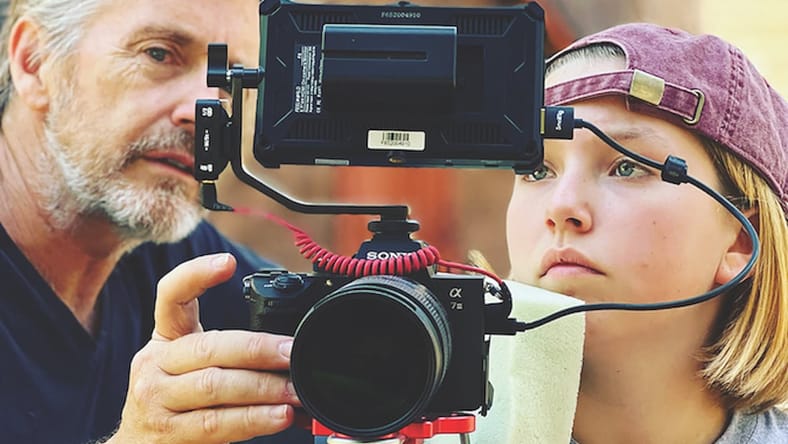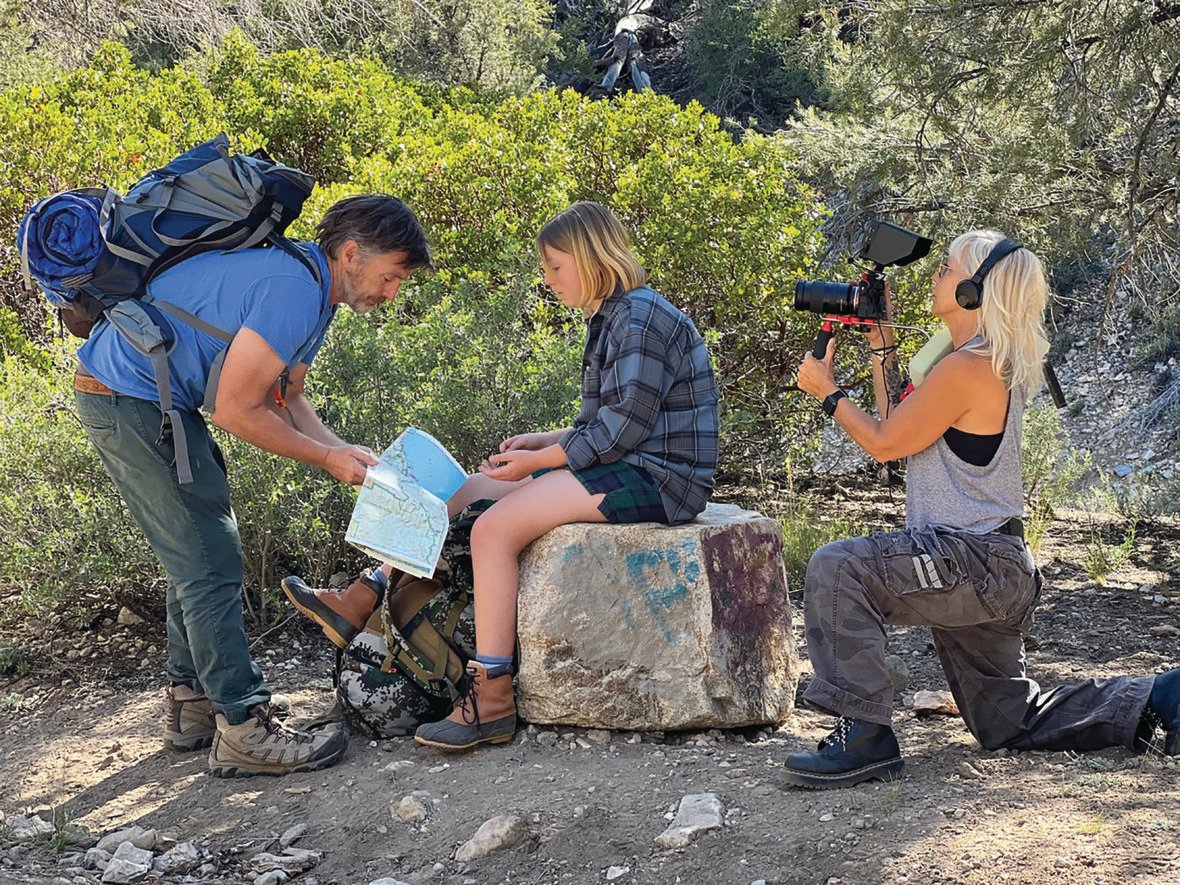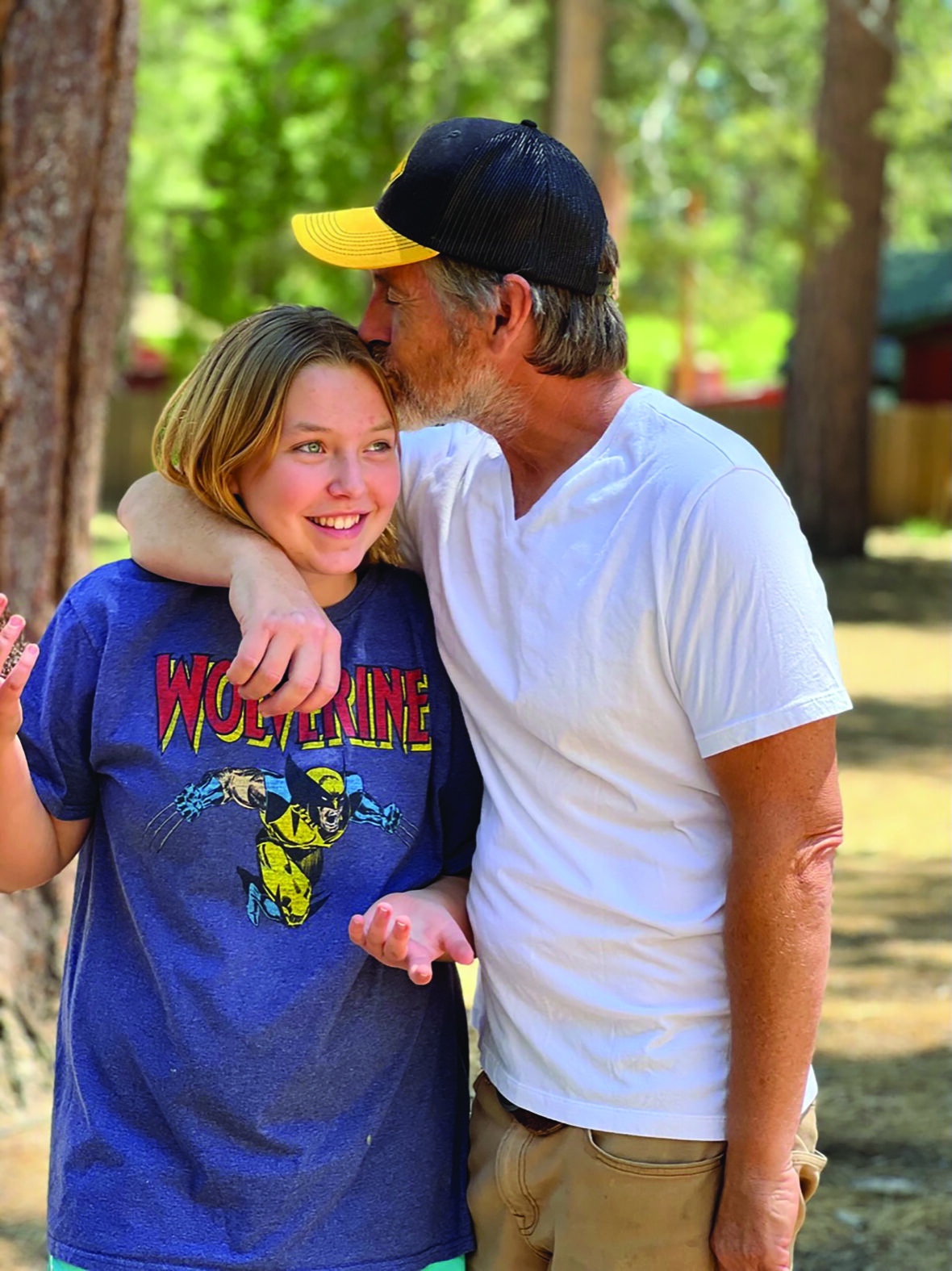
In the latest in our Films at Any Budget series, director Doug Purdy explains how he and his daughter Scout led their feature film Pilgrim with dozens of extras and locations — at a micro-budget. You can read other stories in the series here.
“Dad, I wanna make a movie with you.”
Nothing in the world will get the creative juices flowing more than hearing these words from your 14-year-old daughter. Mine is named Scout.
“So, specifically, what does that mean?” I asked her. “Do you wanna write? Act? Direct?”
“Yes.”
Movies have been part of our family from the beginning. My wife Brooke and I met in an acting class years ago. We got married and continued to pursue our dreams, but then kids came along, and priorities shifted. Cut to seven years ago, as we realized we still had those same dreams. So we made a low-budget film together called Quality Problems. Brooke wrote. We both directed. Our friends Jen Prince, Jhennifer Webberley and Colette Freedman produced. And we cast ourselves and our kids as the leads.
We had a successful crowdfunding campaign through Seed&Spark, and boom — we were off to the races. We won awards. Got into tons of festivals. Got distribution. It was awesome.

Then it stopped. It was over. And nothing truly remarkable happened as a result of our efforts.
And we realized: We’ve got to do it again. That’s the high. The end you’re going after. The “doing.” And so we did.
The first challenge we saw was that crowdfunding is not a well you can keep going back to. Your friends and family are happy to help out on one project. Maybe two. But after a while, it gets old. And everybody is asking for money. So we realized we needed a new model. One that isn’t dependent on cash and big favors.
Time to cowboy up.
The first thing we had to do was find a story. Scout and I would brainstorm for a while, getting nowhere. Every time we thought we had something, we realized it had been done. But we just kept at it.
One day, as Scout was looking at her screensaver image of a beautiful mountain range, she said, “That should be a movie.” And suddenly we had it.
Writing Pilgrim
Our logline: When an overachieving teenager hikes the Pacific Coastal Trail in order to connect with her dead mother, she is suddenly forced to address her dysfunctional relationship with her man-child father.
We banged out a rough outline for what would become Pilgrim and quickly moved on to the script itself. We would take turns: She’d write a scene or two after school. Then I’d come home from work and bang one out. It basically became an improv where we kept yes and-ing each other. Truly painless. We had a script in two or three months. We watched a ton of movies to prepare, including a lot of Ed Burns’ work, specifically 2011’s Newlyweds. He got that in the can for $9,000, and it revived his career. Another odd source of inspiration was The Texas Chainsaw Massacre. Tobe Hooper said that the movie was a shot from a flare gun he sent out from Texas. He didn’t let financial constraints keep him from making a now-classic film.
Next up was the daunting task of figuring out how we were going to pay for our film. Obviously, crowdfunding came up. Sure, we could go that route, and we’d probably raise a decent amount, since it had been a while. But I really wanted to do something different. What if we truly tried to shoot this thing for next to nothing? Almost as an experiment? Sure, it would be a challenge, and we would have to be very creative. We went back and forth on it, and eventually I won her over. And this led us to really develop our own style, both aesthetically and in our model of filmmaking. See, when you don’t have anything, you are beholden to no one. You can create your own rules. You can be fearless. You are in complete control.
And, oddly enough, without that fear of failure, you make bolder choices.
To spend the least amount of money possible, we purposely only used locations we could get for free, or almost for free. Colette is a playwright, script doctor and ghost writer who teaches screenwriting at Antioch University, and our best get was from one of her Antioch MFA students — she has had a Big Bear Lake property in her family since 1914. It was relatively close to Burbank, where we live, and has eight cabins and several acres of surrounding land. We shot half of the film there, using most of the cabins, as well as the mountains, woods, hiking paths and the lake. It was magical. Our biggest expense was food — feeding the cast three meals a day — and paying actors’ gas money to get up the mountain.

Filming Pilgrim
It took us approximately two months to shoot the entire film piecemeal. We spent a week in Big Bear, shooting seven to 10 pages of Pilgrim a day. But to avoid the harsh midday sun, we shot from 5 a.m. to 9 a.m. and from 7 p.m. to midnight. We each did the work of three people every day.
In terms of gear, we kept it simple. In the year leading up to the shoot, Brooke and I had directed shorts, and my son Max had done a bunch on his own. So we already had a good camera. We used a Sony a7iii that we shot in 4k with a custom Cine 4 profile. (I know everyone says to shoot in log format, which allows you to capture and retain more information from the camera’s sensor, which allows you more options in post.
Since we were moving so fast, I wanted to have something I liked and trusted in the monitor. But if i were to do it again, I’d shoot in log. Max has turned me on to it). We used one lens, a Tamron 28-70 zoom, because we didn’t want to slow down to switch lenses. We also used a cheap neutral-density filter — a must since we were doing so many daytime exteriors.
Also Read: Razzies Apologize to 12-Year-Old Nominee, Set New Age Limits
For sound we used Rode lavs, which worked amazingly. People are shocked that we got the sound we did on these cheap little lavs. We also used a Zoom H1 as a boom/backup mic, but we barely used the audio from it, since the lavs were so good. We did have a couple days where the lavs ran out of juice, so we threw on a Rode shotgun mic. I was terrified to hear that footage when we dumped it into the computer, but you couldn’t tell the difference. It sounded great.
We had a Neewer LED lighting package, and it works great — but honestly we used practicals with adjustable temperature light bulbs for the vast majority of shooting. And by far the best source of light we used was fire. The campfire and fireplace scenes are probably the most beautifully lit scenes in the film.
We started off planning to shoot Pilgrim with a mix of sticks and handheld and gimbal shots in a specific order to signify the journey of Scout’s character, but we realized early on that we just loved the handheld look. The sticks shots started showing the lack of money, and made things really slow. But once we put the camera on a borrowed Revo shoulder mount, the scenes really came to life. We got a vérité/doc look reminiscent of Friday Night Lights. And we could move so fast. Max would hide the camera in a big jacket, and we’d steal shots everywhere: grocery stores, train stations, trains — you name it. You just can’t do that with a camera that’s locked down.
Our cast and crew were basically one and the same. Scout and I wrote and directed. Colette produced, acted and did whatever else was necessary to keep Scout and I from being spread too thin. Brooke, Max and I shot everything with our friend Riley Dismore, and we all acted as well. Scout also ran camera by the end of the shoot. Our editor, Tom Flynn, acted also. But no one seemed to mind. We were all learning as we went. It was just fun.
The Pilgrim cast was around 20 people, and we had about 30 locations. Everyone says to keep your cast and locations to a minimum. But we were able to move quickly and discreetly. We shot one scene in a diner, and were in and out in 45 minutes, with full coverage and B roll. (The waitress got a big tip.) We shot at a graduation ceremony, a farmers market, and a library — but hardly anybody could tell what we were doing, because we left such a small footprint.
Pilgrim Lessons
Luckily, the new SAG-AFTRA Micro-Budget Project Agreement allows union actors to work in projects shot under $20,000. Colette and I are both SAG actors, as are Ryan Bollman and Jenica Bergere, who were both in Quality Problems. The new agreement is a game changer and allows us to work with actors we love.
Film has historically been a very expensive medium with a high barrier to entry. But that’s changing. The tech is getting so good that you can just go out and do it. I’d love to do this like a repertory company where we can be in post on one film and in pre-production on another. It’s possible at very low budgets like ours. As of this writing, the film is in post production, and we’re looking forward to entering festivals in search of distribution.
Shooting films the way we shot Pilgrim means that we aren’t waiting around for someone to let us make a movie, and I plan to keep growing with this model. Sure, if someone came to us and said, “Here’s a bunch of money!,” I’d gladly take it. And it would certainly make selling the thing a whole lot easier. But in the meantime, isn’t it just about creating stories?
Main image: Doug Purdy and Scout Purdy on the set of Pilgrim. Photo by Colette Freedman.
Share:

